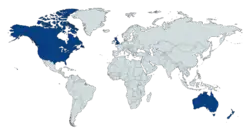Five Nations Passport Group | |
|---|---|
 Five Nations shown in dark blue | |
| Members | |
The Five Nations Passport Group is an international forum for the passport-issuing authorities of Australia, Canada, New Zealand, the United Kingdom and the United States to share best practices in the issuance, development, and management of passports.[1][2] The annual Five Nations Passport Conference is a largely informal in-person meeting between officials of the participating agencies, with some additional invited guests such as the Irish Department of Foreign Affairs and Trade in 2011. It has taken place since at least as far back as 2004.[3]
The member states' issuing authorities are comparable to each other: their passport issuance systems are mostly centralised and their service channels are similar to each other.[4] None of the Five Nations countries has a compulsory identity management system, which means that citizens' personal information is not available in a central citizenship database or registry.[4]
Participating issuing authorities
The agency that participates in the Five Nations Passport Group for each state is their relevant passport-issuing authority:
Passport specifications
Unlike EU passports, which follow a common format, Five Nations passports develop through the sharing of best practices and information relating to the development of passports. However, all Five Nations passports are biometric and machine-readable, and B7 sized (ISO/IEC 7810 ID-3, 88 mm × 125 mm).
Generally, Five Nations passport holders have access to each other's automated border control systems. Currently, all Five Nations passport holders have access to Australia and New Zealand's SmartGate system[5] and the UK's ePassport gates.[6] Similarly, British passport holders[lower-alpha 1] have access to the US's Global Entry programme, while Canadians have access to the NEXUS programme.[7] Australia is also planning to participate in Global Entry.[8]
Passport circulation
The numbers of Five Nations passports in circulation are:
| Passport | Numbers of circulating passports | |
|---|---|---|
| 14,614,941 (2020) | ||
| 23,790,000 (2018) | ||
| 2,900,000 | ||
| 51,116,513 (2019) | ||
| 2,240 (2019) | ||
| 421,828 (2019) | ||
| 143,116,633[lower-alpha 2] (2020 fiscal year) | ||
See also
Notes
- ↑ Restricted to citizens of the United Kingdom only
- ↑ Includes United States Passport Cards
References
- ↑ Passport Canada: International comparison of passport-issuing authorities Archived September 18, 2011, at the Wayback Machine
- ↑ "Australian Government Department of Foreign Affairs and Trade: Accountant profile – Adeel". Archived from the original on June 6, 2011.
- ↑ "Five Nations Passport Group meetings - a Freedom of Information request to HM Passport Office". 26 November 2013.
- 1 2 "International Comparison of Passport-Issuing Authorities" (PDF). Canada.ca. March 2012. p. 7. Retrieved 10 May 2020.
- ↑ "Smartgates". www.abf.gov.au. Retrieved 2020-05-10.
- ↑ "ePassport gates to ease travel for passengers from more countries". GOV.UK. Retrieved 2020-05-10.
- ↑ "Eligibility for Global Entry | U.S. Customs and Border Protection". www.cbp.gov. Retrieved 2020-05-10.
- ↑ "US Global Entry trial for Australian citizens to start in 2019". Executive Traveller. Retrieved 2020-05-10.
- ↑ Office, Australian Passport (2018-03-02). "2019-20 Passport Facts". Australian Passport Office. Retrieved 2021-03-06.
- ↑ Immigration, Refugees and Citizenship Canada (2020-02-04). "Passport Program Annual Report for 2017 to 2018". aem. Retrieved 2020-05-13.
- ↑ Observatory of Public Sector Innovation: "Online Passport Renewal Service (ORS)". OECD. Retrieved 24 November 2017.
- ↑ "FOICR 57241 Luke Lo final response" (PDF). 11 February 2020. Retrieved 14 February 2020.
- ↑ Crown dependencies and overseas territories
- ↑ Passport Statistics. U.S. Department of State - Bureau of Consular Affairs. Retrieved 6 March 2021.